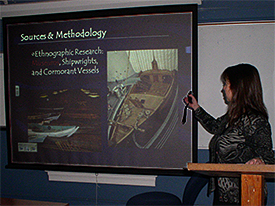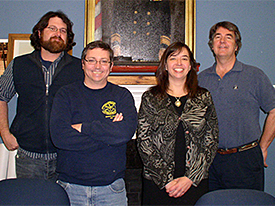
The End
20 April 2010
By Michelle Damian

Michelle presenting at her MA thesis defense.
I have been waiting for a long time to type up this post. I'm happy to say that my thesis journey has come to a close: I successfully defended my thesis in March of this year. The whole process has been illuminating. It's difficult to summarize several years of research into just a few paragraphs, but one topic that stood out to me was the value of artwork in understanding more about an aspect of society. When I first began this project, one commentator suggested that woodblock prints would be of little value in understanding shipbuilding. While I agree that it would be difficult to build a seaworthy vessel based solely off woodblock prints, I do think they provide a wealth of information not only about basic aspects of ship construction but perhaps even more importantly about the context in which the boats were used. Archaeology is, at its heart, about learning about people. The woodblock prints allow us to understand more about how Edo-period Japanese worked and played on the water.
The range and types of boats present in the prints demonstrate the prevalence of watercraft in everyday life of Edo Japan. Nearly two hundred prints in my data set showed some kind of watercraft, ranging from exquisitely detailed river vessels, to lumber rafts, to a simple white square on the horizon indicating the sail of a seagoing ship. I created a map on Google Earth placing those images that I could identify in an approximate location. Correlating the locations and types of boats in the prints helps show where the maritime centers of commerce, fishing, and pleasure boating may have been. These findings, though, are always tempered by a discussion of artistic license. Particularly as landscape prints gained commercial popularity as souvenirs for travelers, artists may have created more and more prints depicting popular destinations, skewing the data set toward those locations.1 Combining the images with other documentary, ethnographic, and archaeological evidence provides a fuller picture of maritime Japan. This study has just begun to scratch the surface.
I began this project journal saying that I wanted to not only share knowledge about Japanese maritime topics, but that I also wanted to talk about the thesis process itself, so I'd like to write a bit about the logistics of defending. After finishing a draft of the thesis, sending it to my committee for editing and comments, and revising it throughout fall 2009, I returned to ECU ready to defend my thesis. I'd been told to prepare a 20 minute presentation on my thesis, consisting of a brief outline of the project, my sources (and potential pitfalls in using those sources), and a short introduction into the types of findings. ECU's thesis defenses are open, meaning that anyone can attend. I was happily surprised that in addition to my committee a large number of students also came to see the defense, though perhaps that was more to see what they will have to go through when they are ready to defend their own theses.

Michelle and her committee. From left to right: Dr. Nathan Richards, Dr. David Stewart, Michelle Damian, and Dr. Brad Rodgers (Not present: Dr. Hans Van Tilburg).
After my presentation, my committee first asked several questions mostly focused on exploring further ramifications of my work, including environmental and other global connections. Then the floor was opened to other professors attending the defense, and finally to other students as well. Fortunately my answers seemed to satisfy the questioners; as there is so much left to do on Japanese maritime archaeology there is a lot of room for future research. When the questioning period was over, everyone but the committee left the room to determine whether I had passed or not.... and shortly the door opened with everyone all smiles.
The aftermath was oddly anticlimactic. ECU has recently adopted an electronic-only submission process, and as the first maritime student to go through that entire procedure there were some logistic hurdles regarding formatting and copyrights. I spent the next three days making those tweaks and getting all of the necessary signatures, and then finally hit the "submit" button online. It took several weeks for all the format checks to clear, but after all that an email landed containing the wonderful words: "Michelle M. Damian... has completed all requirements for the MA degree in Maritime History and Nautical Archaeology."
And so that brings this chapter to a close. There are many people to thank that have helped me on this journey - a number are listed on the acknowledgments page of this journal, but I also want to say a special thanks to a few more. Dr. Karen Gerhart read an early draft of the thesis and provided much food for thought. Kristen and Dave Bradanese were a source of emotional support and more, particularly in the final days of the project. Kurt Knoerl not only gave me the opportunity to present this journal on the MUA, but was the person who got me started into underwater archaeology in the first place, and I owe him great thanks for that. My committee of Dr. Nathan Richards, Dr. David Stewart, Dr. Hans Van Tilburg, and especially my advisor, Dr. Brad Rodgers, has been incredibly helpful for their comments and guidance throughout. Finally, I need to thank my mom for all of her encouragement - she's probably almost as happy as I am that I am done with this!
Done with this project, perhaps... but still studying. My PhD research is taking me further back in time to study maritime communities in fifteenth-century Japan. As I said, I've so far only just scratched the surface of maritime Japan - there is still far more to come in the future!
Please feel free to contact Michelle regarding her journal at muaprojectjournal@yahoo.com .
________________
1 One travel guidebook from the time extolled woodblock prints as the "best gift" to bring home from one's travels. See Constantine Nomikos Vaporis, Breaking Barriers: Travel and the State in Early Modern Japan (Harvard University Asia Center, 1995), 224.
Return to Project Journal home page.

